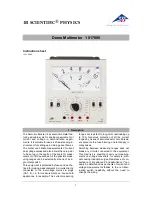
13
3. SPECIFICATIONS
DC VOLTAGES
Connect the leads to the multimeter and connect in parallel to the circuit to be
tested.
When the order of magnitude is not known, place the switch on the highest range
then progressively lower to the appropriate range.
To get the voltage in V, multiply the value read on the appropriate scale by the
reading coefficient shown in the table.
V
100 mV
(1)
1 V
3 V
10 V
30 V
100 V
300 V
1000 V
Scale
100
100
30
100
30
100
30
100
Reading
coefficient
x1
(2)
x0.01
x0.1
x0.1
x1
x1
x10
x10
Internal
resistance
(3)
2 kΩ
20 kΩ
63.2 kΩ
200 kΩ
632 kΩ
2 MΩ
6.32 MΩ
6.32 MΩ
Accuracy
(4)
1.5 %
Permitted
overload
420 V
1000 V
(5)
1500 V
(5)
(1) Common to the 50 µA
range
(2) Direct reading in mV
(3) Specific R: 20 kΩ/V, except range 1000 V - R = 6.32 kΩ/V
(4) In % of the end of scale
(5) For 15 seconds
AC VOLTAGES
V
10 V
30 V
100 V
300 V
1000 V
Scale
100
30
100
30
100
Reading
coefficient
x0.01
x1
x1
x10
x10
Internal
resistance
(1)
63.2 kΩ
200 kΩ
632 kΩ
2 MΩ
6.32 MΩ
Accuracy
(2)
2.5 %
2 %
Bandwidth
(3)
10 Hz ... 100 kHz
10 Hz ... 50 kHz
10 Hz ... 25 kHz
10 Hz ... 1 kHz
Permitted
overload
420 V
1000 V
(4)
1500 V
(4)
(1) Specific R: 6.32 kΩ/V
(2) In % of the end of scale
(3) See § 4
(4) For 15 seconds
Presence of direct component give false measurement.
DECIBELS
Reminder:
The measurement of an AC voltage can be expressed in decibels
(symbol dB). The decibel is the ratio of two quantities or level. Level N, in dB, of a
voltage U has the mathematical expression: N(dB) = 20 log
10
(U/U
0
)
U
0
is the reference voltage of 0.775 V
for a power P
0
of 1 MW on a load of
600 Ω.














































